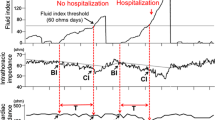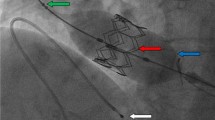Abstract
Aims
Encouraging data have been reported on the use of cardiogenic impedance (CI) in cardiac resynchronization therapy (CRT) optimization. The purposes of this study were to: evaluate the stability of certain CI vectors 24 h postimplantation, study the correlation between these CI signals and selected echocardiographic parameters, and examine the possibility of non-invasive calibration of the patient-specific impedance-based prediction model.
Methods and results
Thirteen patients received a CRT–defibrillator device with monitor capability of the dynamic impedance between several electrodes. At implantation, a patient-specific impedance-based prediction model was created for identification of optimal atrioventricular and interventricular (VV) delays and calibrated on invasive measurements of left ventricular contractility (LV dP/dtmax). Simultaneously, non-invasive measurements of LV dP/dtmax and stroke volume (SV) were obtained using a finger plethysmograph. Patients were re-evaluated with echocardiography and new CI measurements the day after implantation. The hemodynamic benefit achieved by optimal VV setting according to the patient-specific impedance-based prediction model at follow-up was not as large as the one obtained at implantation. In a multivariate partial least square regression analysis, a correlation was found between aortic velocity time integral (VTI) and a generic linear combination of CI features (P < 0,005). No correlation was found between the patient-specific impedance-based prediction models and the non-invasive measurements of LV dP/dtmax and SV.
Conclusion
Cardiogenic impedance signals can be used to optimize CRT settings but seem less feasible as an ambulatory tool since calibration is required. The positive correlation between aortic VTI and CI measurements seems promising, although a larger cohort is required to create an echocardiography-based patient-specific model.



Similar content being viewed by others
References
Cazeau, S., Leclercq, C., Lavergne, T., Walker, S., Varma, C., Multisite Stimulation in Cardiomyopathies (MUSTIC) Study investigators, et al. (2001). Effects of multisite biventricular pacing in patients with heart failure and intraventricular contraction delay. The New England Journal of Medicine, 344, 873–880.
Bristow, M. R., Saxon, L. A., Boehmer, J., Krueger, S., Kass, D. A., De Marco, T., et al. (2004). Comparison of Medical Therapy, Pacing and Defibrillation in Heart Failure (COMPANION) investigators. Cardiac resynchronization therapy with or without an implantable defibrillator in advanced chronic heart failure. The New England Journal of Medicine, 350, 2140–2150.
Cleland, J. F. G., Daubert, J. C., Erdmann, E., Freemantle, N., Gras, D., Kappenberger, L., et al. (2005). Cardiac resynchronization study (CARE-HF) investigators. The effect of cardiac resynchronization on morbidity and mortality in heart failure. The New England Journal of Medicine, 352, 1539–1549.
Young, J. B., Abraham, W. T., Smith, A. L., Leon, A. R., Lieberman, R., Wilkoff, B., et al. (2003). Combine cardiac resynchronization and implantable cardioversion defibrillation in advanced chronic heart failure: the MIRACLE ICD trial. Journal of the American Medical Association, 289, 2685–2694.
Bradley, D. J., Bradley, E. A., Baughman, K. L., Berger, R. D., Calkins, H., Goodman, S. N., et al. (2003). Cardiac resynchronization and death from progressive heart failure: a meta-analysis of randomized controlled trials. Journal of the American Medical Association, 289, 730–740.
Mortensen, P. T., Sogaard, P., Mansour, H., Ponsonaille, J., Gras, D., Lazarus, A., et al. (2004). Sequential biventricular pacing: evaluation of safety and efficacy. Pacing and Clinical Electrophysiology, 27, 339–345.
Sogaard, P., Egeblad, H., Pedersen, A. K., Kim, W. Y., Kristensen, B. O., Hansen, P. S., et al. (2002). Sequential versus simultaneous biventricular resynchronization for severe heart failure: evaluation by tissue Doppler imaging. Circulation, 106, 2078–2084.
Vidal, B., Stiges, M., Marigliano, A., Delgado, V., Diaz-Infante, E., Azqueta, M., et al. (2007). Optimizing the programation of cardiac resynchronization therapy devices in patients with heart failure and left bundle branch block. The American Journal of Cardiology, 100, 1002–1006.
Boriani, G., Muller, C. P., Seidl, K. H., et al. (2006). Randomized comparison of simultaneous biventricular stimulation versus optimized interventricular delay in cardiac resynchronization therapy. The Resynchronization for the HemodYnamic Treatment for Heart Failure Management II implantable cardioverter defibrillator (RHTYTHM II ICD) study. American Heart Journal, 151, 1050–1058.
Rao, R. K., Kumar, U. N., Shafer, J., et al. (2007). Reduced ventricular volumes and improved systolic function with cardiac resynchronization therapy: a randomized trial comparing simultaneous biventricular pacing, sequential biventricular pacing, and left ventricular pacing. Circulation, 115, 2136–2144.
Leon, A. R., Abraham, W. T., Brozena, S., Daubert, J. P., et al. (2005). Cardiac resynchronization with sequential biventricular pacing for the treatment of moderate-to-severe heart failure. Journal of the American College of Cardiology, 46, 2298–2304.
Perego, G. B., Chianca, R., Facchini, M., Frattola, A., Balla, E., Zucchi, S., et al. (2003). Simultaneous vs sequential biventricular pacing in dilated cardiomyopathy: an acute hemodynamic study. European Journal of Heart Failure, 5, 305–313.
Van Gelder, B. M., Bracke, F. A., Meijer, A., Lakerveld, L. J., & Pijls, N. H. (2004). Effect of optimizing the VV interval on left ventricular contractility in cardiac resynchronization therapy. The American Journal of Cardiology, 93, 1500–1503.
Baker, J. H., II, McKanzie, J., III, Beau, S., Greer, G. S., Porterfield, J., Fedor, M., et al. (2007). Acute evaluation of programmer-guided AV/PV and VV delay optimization comparing an IEGM method and echocardiogram for cardiac resynchronization therapy in heart failure patients and dual chamber ICD implants. Journal of Cardiovascular Electrophysiology, 18, 185–191.
Abraham, W. T., et al. (2010). Results from the FREEDOM trial—assess the safety and efficacy of frequent optimization of cardiac resynchronization therapy. SP08. Late breaking trials, HRS 2010. Denver, Colorado.
Van Gelder, B. M., Meijer, A., & Bracke, F. A. (2008). The optimized V-V interval determined by interventricular conduction times versus invasive measurements by LV dP/dtmax. Journal of Cardiovascular Electrophysiology, 1, 1–6.
Ginks, M. R., Sciaraffia, E., Karlsson, A., Gustafsson, J., Hamid, S., Bostock, J., et al. (2011). Relationship between intracardiac impedance and left ventricular contractility in patients undergoing cardiac resynchronization therapy. Europace, 13, 984–991.
Jansen, A. H., Bracke, F. A., van Dantzig, J. M., Meijer, A., van der Voort, P. H., Aaurnoudse, W., et al. (2006). Correlation of echo-Doppler optimization of atrioventricular delay in cardiac resynchronization therapy with invasive hemodynamics in patients with heart failure secondary to ischemic or idiopathic dilated cardiomyopathy. The American Journal of Cardiology, 97, 552–557.
Kerlan, J. E., Sawhney, N. S., Waggoner, A. D., Chawla, M. K., Garhwal, S., Osborn, J. L., et al. (2006). Prospective comparison of echocardiographic atrioventricular delay optimization methods for cardiac resynchronization therapy. Heart Rhythm, 3, 148–154.
Butter, C., Stellbrink, C., Belalcazar, A., et al. (2004). Cardiac resynchronization therapy optimization by finger plethysmography. Heart Rhythm, 1, 568–575.
Whinnett, Z. I., Davies, J. E., Willson, K., Manisty, C. H., Chow, A. W., et al. (2006). Hemodynamic effects of changes in atrioventricular and interventricular delay in cardiac resynchronization therapy show a consistent pattern: analysis of shape, magnitude and relative importance of atrioventricular and interventricular delay. Heart, 92, 1628–1634.
Author information
Authors and Affiliations
Corresponding author
Rights and permissions
About this article
Cite this article
Sciaraffia, E., Ginks, M.R., Gustafsson, J. et al. The reliability of cardiogenic impedance and correlation with echocardiographic and plethysmographic parameters for predicting CRT time intervals post implantation. J Interv Card Electrophysiol 37, 155–162 (2013). https://doi.org/10.1007/s10840-013-9795-5
Received:
Accepted:
Published:
Issue Date:
DOI: https://doi.org/10.1007/s10840-013-9795-5




